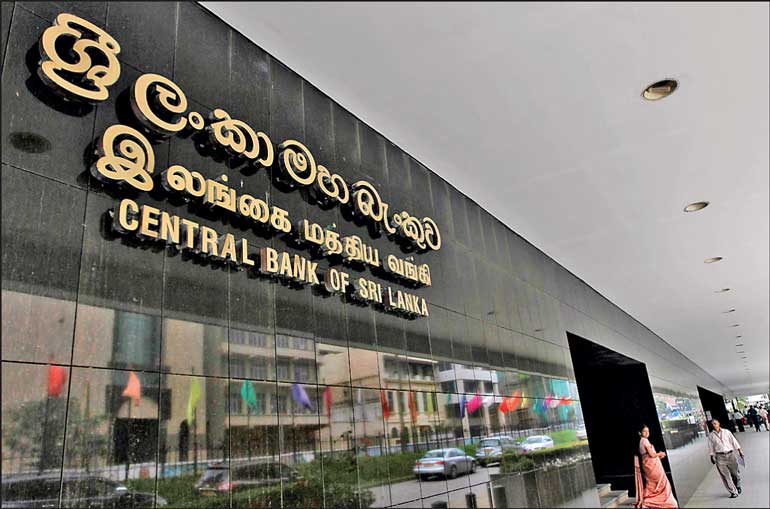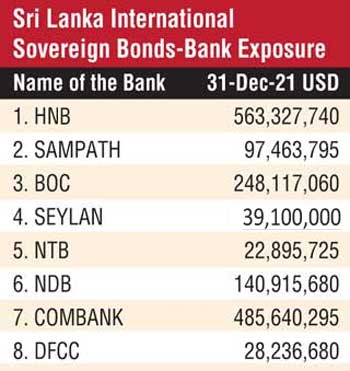Monday Apr 07, 2025
Monday Apr 07, 2025
Thursday, 28 April 2022 00:20 - - {{hitsCtrl.values.hits}}

Several people on many of my social media platforms contacted me, asking for advice about the stability of the commercial banks in the country, given that I had been the chairman of the two of the largest private banks in the country.
largest private banks in the country.
Their concerns were further amplified when former Prime Minister Ranil Wickremesinghe said publicly that some banks in the country are in danger of collapsing. The leader of the UNP made these comments while addressing a gathering of bankers last week.
He said: “The economy cannot survive without banks. We need a safety net to protect the banks. The combination of the forex crisis and the collapse of the banks is not something to be taken lightly.” He asserted, “Some of our banks are on the brink of collapsing and some of them will have to be rebuilt.”
All licensed commercial banks in the country are certainly facing a huge crunch in foreign exchange; this is despite the controversial floating of the LKR by the Central Bank where worker remittances now can be converted to Sri Lanka rupees at a much higher rate after the Central Bank of Sri Lanka floated the Sri Lanka rupee in March 2022. There still is no clarity as to whether the floating was done by the monetary board or unilaterally by the then Governor with the concurrence of the then Treasury Secretary and Finance Minister.
The outcome of that action has created mayhem in the local financial markets. A lot more blood will have to be spilt before there is some order in our financial markets. The worst hit from this excess is the Sri Lankan middle class and the daily wage earners. As forex liquidity dries up across the banking sector, and with investors pulling out money from risky markets, the Sri Lankan recovery will become even murkier and difficult.
IMF and Indian support
The real challenge for banks is that they are starved of forex flows and the forex inflows projected for the country looks very precarious. So even if we assume rollovers which may be the smart thing now, even in forward derivatives and swaps, what the banks need more than anything, is ready access to forex liquidity and infusion of that is critical, though looking at our existing forex reserves, the Central Bank doesn’t have usable reserves to do it right now and that is why the short-term bridging financing is so important. So while we were expecting up to $ 2 billion from India as bridging finance once the IMF deal was put on track, however now this may be released in tranches. First of that was a $ 500 million approved for fuel. The Chinese $ 2 billion is still unknown, apart from the fact that $ 1 billion is for debt rollover. 
According to sources the initial IMF talks have not gone according to plan where Sri Lanka was expecting IMF to agree to a Rapid Financing Instrument (RFI) up to our eligibility of $ 1 billion. IMF according to sources while understanding our inability to provide a detailed account of making our debt sustainable until advisors get into action.
The IMF, apparently, has asked for a fiscal plan (tax, rightsizing and expenditure cuts) in the interim to at least consider the RFI. So the RFI which was expected to be released by the IMF around mid-May as bridging finance until the full deal was finalised, now could get pushed back a further four weeks. This will have serious ramifications on the credit lines expected from India. Sources say India is awaiting at least an RFI positive signal from the IMF as a proxy that the IMF program is now on track in order for them to release the bridging funding of approximately $ 2 billion. This money is a must to get over the next two-three months. Fortunately the World Bank over the next four months is to give $ 300 million to $ 600 million to buy medicine and other essential items, this must certainly be subject to a transparent procurement process.
The future for banks
The situation for the banks is tough, especially for the State banks, as the Treasury has used the State banks as their punching bags for decades. The truth is all the commercial banks in the country are facing a huge crunch in foreign exchange inflows, and this is despite the inward remittances can now be converted to Sri Lanka rupees at a much higher rate; in addition, the tourism moratoriums need resolution and Sri Lankans are looking for alternative investments outside the banking system. The massive increase in rates by the CBSL was not required and should have happened gradually. The implications of this decision will be seen in the next few months mainly for SMEs.
The other issue is: it’s a race against a deadline to get concurrence from the interest coupon holders not paid on 18/4 prior to 18/5. If this is not obtained it’s a hard default which will make life really difficult for the Government. The banks as a result will be forced to take a capital haircut on the ISBs (and possibly the TB holdings) and forex impairments on the USD loan books. Banks also are the main investors in SLDBs. Capital augmentation would be a challenge at best in today’s environment. Bank customers need to be shielded from the excesses of the banks’ management and incompetent boards.
Legislation along the line of the Dodd-Frank Act with a inbuilt proxy of a Volker Rule needs to be introduced to ring fence banks customers’ hard earned savings in banks that engage in off-stream banking by engaging in debt and equity markets in bond and equity trading, taking positions on debt and forex, M&A, Swaps and derivatives, IPOs, custodial services and even margin trading, etc. Banks will require boards with deep understanding of banking to manage the crisis on hand. A system overhaul is required to strengthen the banks.
Conclusion
Unfortunately for most banks the two years of the pandemic did not help them enter this manmade crisis period from a position of strategic and financial strength. The banks’ ratings will continue to be constrained by the sovereign credit profile. The forex liquidity crisis and the ongoing moratoriums will hurt all banks. The next one-three years for the banks are crucial times for them. Boards therefore must lead with confidence and provide oversight rather than manage, but they must have the experience to gauge the creeping impact on their bank.
The private sector banks despite these challenges must/can overcome this if the regulator and the Government gives them the space to do what is best for their depositors (85-90% of the funds deployed). Also, bureaucrats sitting in the treasury and presidential secretariat must stop using the banks as their punching bags and those responsible (including their cronies) for creating this economic crisis must be held accountable in the future to ensure a sustainable future for the banks and their depositors.
(The writer was a bank director from 2003-2021 and chaired the banking sector consolidation committee in 2016.)
Discover Kapruka, the leading online shopping platform in Sri Lanka, where you can conveniently send Gifts and Flowers to your loved ones for any event including Valentine ’s Day. Explore a wide range of popular Shopping Categories on Kapruka, including Toys, Groceries, Electronics, Birthday Cakes, Fruits, Chocolates, Flower Bouquets, Clothing, Watches, Lingerie, Gift Sets and Jewellery. Also if you’re interested in selling with Kapruka, Partner Central by Kapruka is the best solution to start with. Moreover, through Kapruka Global Shop, you can also enjoy the convenience of purchasing products from renowned platforms like Amazon and eBay and have them delivered to Sri Lanka.
Discover Kapruka, the leading online shopping platform in Sri Lanka, where you can conveniently send Gifts and Flowers to your loved ones for any event including Valentine ’s Day. Explore a wide range of popular Shopping Categories on Kapruka, including Toys, Groceries, Electronics, Birthday Cakes, Fruits, Chocolates, Flower Bouquets, Clothing, Watches, Lingerie, Gift Sets and Jewellery. Also if you’re interested in selling with Kapruka, Partner Central by Kapruka is the best solution to start with. Moreover, through Kapruka Global Shop, you can also enjoy the convenience of purchasing products from renowned platforms like Amazon and eBay and have them delivered to Sri Lanka.